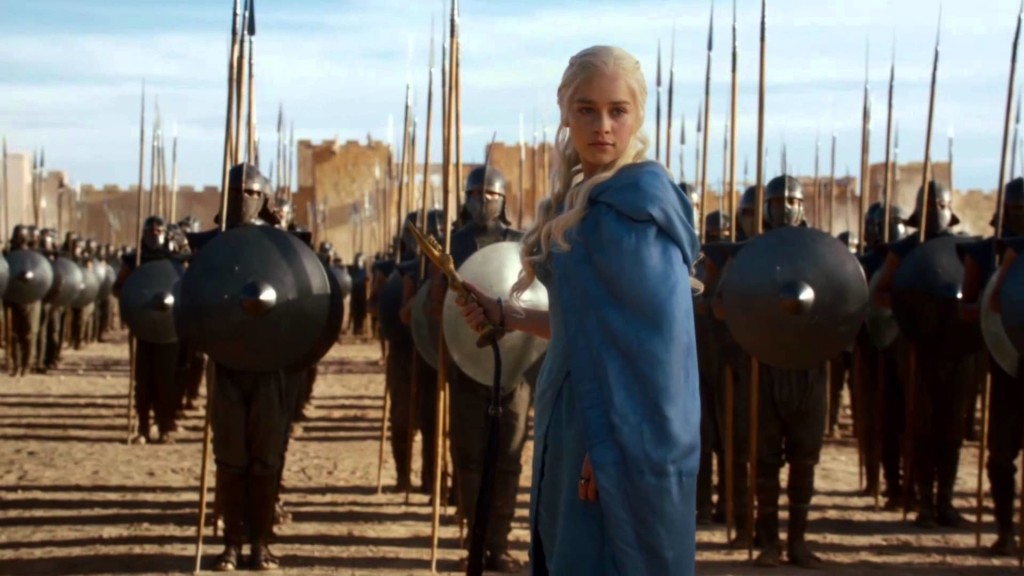
“All men must die. But we are not men…” — Daenerys Targaryen
We don’t have HBO, so were late getting into Game of Thrones, only starting to watch it after I accidentally stumbled across a copy [let’s just say, it had Chinese subtitles…]. Being tardy has its benefits: we could binge watch our way through multiple episodes, and I’m wondering how we’ll cope having to join the masses for Season 4, rationed to one episode per week. And it appears we were not alone: it’s one of the rare cases were a show has grown much more popular over time. The first ever episode was watched by only 2.22 million people on HBO. The second season opened 74% higher, at 3.86 million, and by the time the third series ended, viewing figures all the way up at 5.39 million. This mirrors the pattern of the books by George R.R. Martin on which the series is based: the first wasn’t a hit at all on its publication in 1991. But by the end of July 2011, he had five books in the New York Times top 20 bestsellers for fiction.
It’s utterly addictive, and populated with any number of great characters; indeed, some kind of scorecard would probably help in the early going, to keep track of who is marrying, supporting, invading or killing whom. Perhaps the outstanding aspect for me is the way characters are nuanced, something especially noteworthy for the villainous. Even as they are committing heinous acts, you usually understand the reasons why they’re doing them. If you may not agree with the purpose to which they are aimed, you can see the justification. Well, except for boy-king Joffrey. He’s just a little shit, who has somehow managed to avoid the claws of the grim reaper. And speaking of which, another defining factor of the series is: anyone can die, at any time. No matter how beloved, Mr. Martin does not care. You can traumatize any GoT fan by sidling up to them and whispering two words in their ear: “Red Wedding.” I’ll say no more than that.
“The more people you love, the weaker you are.” — Cersei Lannister
 It certainly is a show ‘for mature viewers,’ containing its fair share of violence and sex, which has naturally led to the usual accusations of the usual misogyny from the usual sources. I don’t think the reality is anywhere near as simple as this, not least because the creators are pretty much equal opportunity when it comes to character abuse. Sure, sexual assault is skewed towards the women; decapitation, on the other hand, is pretty much a male preserve. No-one gets out unscathed: man, woman, child or wolf. There’s also an obvious difference between depiction and endorsement. And it’d be kinda ludicrous to have a medieval-styled fantasy world, operating as some kind of anarcho-syndicalist commune, where people take it in turns to be a sort of executive officer for the week, but all the decisions of that officer have to be ratified at a special bi-weekly meeting. Boring as shit, too.
It certainly is a show ‘for mature viewers,’ containing its fair share of violence and sex, which has naturally led to the usual accusations of the usual misogyny from the usual sources. I don’t think the reality is anywhere near as simple as this, not least because the creators are pretty much equal opportunity when it comes to character abuse. Sure, sexual assault is skewed towards the women; decapitation, on the other hand, is pretty much a male preserve. No-one gets out unscathed: man, woman, child or wolf. There’s also an obvious difference between depiction and endorsement. And it’d be kinda ludicrous to have a medieval-styled fantasy world, operating as some kind of anarcho-syndicalist commune, where people take it in turns to be a sort of executive officer for the week, but all the decisions of that officer have to be ratified at a special bi-weekly meeting. Boring as shit, too.
Indeed, perhaps the oppressive world is a seed for the admirable number of strong female characters, which likely surpasses just about any other show on television these days. If you’re a man, you can be remarkably stupid and still do well in the GoT world, as long as you are fairly good at hitting people: Exhibit A, Jon Snow. As a woman, if you’re dumb, you learn quickly, or you don’t survive. If you’re weak, you don’t survive. Since you generally don’t have the option of direct physical force, other means must be found to bend others to do your will. This need not be malicious: Catelyn, matriarch of the Stark family, used family ties and other appeals to loyalty to amass her army. Others are less high-minded; to quote Cersei Lannister, “Tears aren’t a woman’s only weapon. The best one’s between your legs.” And make no mistake, some of the ladies in GoT are perfectly willing to use it, as part of their arsenal of tools.
But only some, for the variety of characters on offer here is another delight, from whores to high priestesses, queens to barbarians (even barbarian queens!), five foot short to six foot three tall, ages nine to eighty and everywhere in between. As the fourth season starts up on Sunday, here are our ten favorites ladies in the Game of Thrones universe to date – in increasing order of action heroineiness. Note: I’ll try and avoid major spoilers – for example, which if any of these are no longer alive! – but where these are necessary to illuminate a character, I’m not going to shy away from them.
“Some day I’m going to put a sword through your eye and out the back of your skull.” — Arya Stark
10. Shae
In terms of social climbing, few can surpass Shae’s ascent. She started off as a prostitute following the Lannister army, but caught the eye of Tyrion Lannister (our most beloved character thanks to Peter Dinklage’s portrayal, the self-proclaimed “god of tits and wine”) and became his exclusively – she even convinced Tyrion to defy his father and bring her to the capital. There, she now serves as a handmaiden and confidant to Sansa Stark, the one-time potential queen of the realm. Yep, Shae has come a long way.
9. Olenna Tyrell
While certainly “veteran presence,” we mentioned above that you don’t survive in this world without being smart and tough. So her lengthy tenure at the heart of court politics testifies to both, as does her nickname, the ‘Queen of Thorns.’ In many way, she’s the real head of House Tyrell, despite marrying into it, rather than through her birth. Besides, we couldn’t omit any character played by Diana Rigg, who was not just the only Mrs. James Bond (in O.H.M.S.S.), but one of the all-time GWG icons, Emma Peel.
8. Melisandre
If there’s one thing more disturbing than your average religious zealot, it’s a religious zealot, with supernatural powers, who burns people alive. That would be Melisandre, a Red Priestess of the Lord of Light, a religion that has found devotees in House Baratheon, and who has an absolute conviction in her faith, to go along with her abilities of prophecy. You get the sense there’s a lot more to her than has been seen to date, but anyone capable of giving birth to shadows that kill on command, is clearly someone to be treated with respect.
“Death by fire is the purest death” — Melisandre
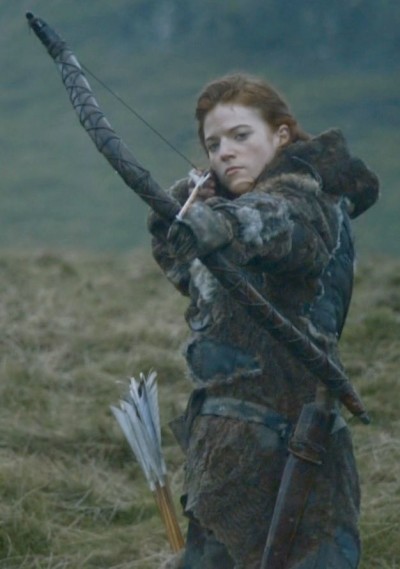 7. Ygritte
7. Ygritte
A free woman from north of the massive wall which protects the bulk of Westeros from… things, shall we say. Life up there is even more brutal, and her survival skills have helped both her and Jon Stark, with whom she has a relationship best described as “complex.” Like others from her society, she possesses a fierce independence, and her loyalty is not easily won. She has an instinctive grasp of the best way to achieve her ends, and will ruthlessly exploit any weakness. If that fails – well, there’s always her trusty bow.
6. Catelyn Stark
At first, she was a dutiful and supportive wife to husband Eddard, but Lady Stark was thrust to the front following his appointment as the King’s Hand, which eventually led to his execution after the death of the current king. As the country collapses into civil war, she strives to be reunited with her children, rallies forces against those responsible for Eddard’s death, and acts as an adviser to her son Robb, who is heading the army they have raised. Balancing these various ends is a perilous task, to say the least.
5. Yara Greyjoy
After a previous rebellion was suppressed, the Greyjoy scion, Theon, was sent off as a hostage to live with the winners, to ensure his family’s future compliance,. This forced his sister, Yara, to step into the breach and become a son by proxy, commanding her own longship and leading her men as they pillage nearby territories. To quote her father: “She’s commanded men. She’s killed men. And she knows who she is.” That’s more than Theon does, completely failing to recognize the hard-ass she has become, when he returns, after almost a decade away.
4. Cersei Lannister
Cersei is played by another solid action heroine, Lena Headey having been Queen Gorgo in 300, as well as the title role in Terminator: The Sarah Connor Chronicles. Her character is responsible for the show’s title, saying, “When you play the game of thrones, you win or you die.” And Cersei Lannister has no intention of dying, being a grand mistress at the arts of scheming, manipulation and intrigue towards her goals. Her son Joffrey is technically on the throne of Westeros, but there’s little doubt who is wielding the actual power there.
“Everyone who isn’t us is an enemy.” — Cersei Lannister
3. Arya Stark
We’re in the top tier now, and despite Arya’s youth, she undeniably deserves her position up here. Virtually the first time we see her, she’s spurning her embroidery lesson to out-shoot her brothers, and that sets the tone for her character. Per Wikipedia, “She rejects the notion that she must become a lady and marry for influence and power, showing no interest in the womanly arts of dancing, singing, and sewing; instead she revels in fighting and exploring.” Her father, Eddard, eventually admits defeat in this area, and hires a swordmaster to give her lessons in “sticking ’em with the pointy end,” an art in which Arya proves adept.
She goes with Eddard when he travels to take up his position as the King’s Hand, but when that goes pear-shaped, she’s thrown back entirely on to her own resources, with her sword, ‘Needle’. Disguising herself as a boy to avoid some of the dangers of life alone, she starts back to her family’s castle in the North. That plan is derailed and she ends up embedded deep in the enemy’s camp, acting as cupbearer to Tywin, the head of House Lannister, before escaping. At the end of the third season, Arya killed her first man, stabbing him repeatedly in the back of his neck. It’s not going to be her last, that’s for sure.
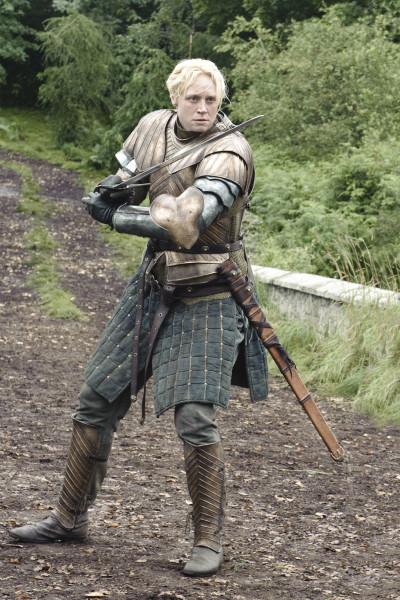 2. Brienne of Tarth
2. Brienne of Tarth
The only child of her lord father, Brienne is bigger and stronger than most men [Gwendoline Christie, who plays her, is 6’3″ in real life, so no need for orange boxes or forced perspective there!], and we first see her winning a tournament against male opponents. This gains her entry in to the Kingsguard of Renly Baratheon, but after his assassination, she is blamed for Renly’s death and has to flee the camp, vowing to take revenge on the real instigator – who would be #8, Melisandre. Brienne swears loyalty to Catelyn Stark, and is given the mission of taking captive Jamie Lannister back to King’s Landing, where he can be exchanged for Catelyn’s daughters. That journey forces both Brienne and Jamie to face uncomfortable truths, and they develop a mutual respect.
Characters in the show are very much shaded in grey, but Brienne is perhaps the closest to being purely good, holding to a chivalric ideal of knighthood, likely more rooted in fantasy than the harsh realities of life. She has managed to hold on to her idealism, despite never being accepted by her fellow knights, or society in general: her position as a warrior woman renders her a perpetual outsider to both groups. In one of the books, she says she was “the only child the gods let [my father] keep. The freakish one, one not fit to be son or daughter.” A great character, beloved beyond the screen time she has received, and I’d love to see a spinoff series, focusing on Brienne.
1. Daenerys Targaryen
The Targaryen clan used to be the rulers of Westeros, but her father was overthrown, leaving Daenerys and her brother Viserys surviving out on the edge of civilization. Viserys still plots to regain the throne, and to this end, arranges a marriage of his sister to a barbarian warlord, Khal Drogo, hoping to use Drogo’s army. Drogo dies after a wound sustained in battle becomes infected, and most of his tribe abandon their queen. However, at this low point, Daenerys discovers her destiny, walking into her husband’s funeral pyre, only to emerge unscathed. Indeed, she succeeds in hatching three supposedly inert dragon eggs given to her as a wedding present, resurrecting a species much feared in their time, yet considered extinct for centuries. The ‘Mother of Dragons’ is on her way back up…
Having not read the books when I watched the series, my initial reaction was that Viserys would be the focus, and Daenerys little more than eye-candy, a bribe used to give her sibling leverage, who’d rapidly be sidelined. Boy, was I wrong. From a chattel, she has steadily ascended the ladder of power, first winning her husband, then his clan, and building upon that, with some help from her little fire-breathers, to become a potential force to be reckoned with. While she is still sidelined – Daenerys hasn’t even set foot on Westeros through three seasons – it’s only a matter of time before she returns at the head of an army, fanatically devoted to her. How do you like your soldiers cooked? Medium-well?
She hasn’t forgotten where she came from either, and has a zero-tolerance policy for those who oppress others. Daenerys has gone from, “I don’t want to be his Queen. I want to go home,” to “Slay the masters, slay the soldiers, slay every man who holds a whip, but harm no child. Strike the chains off every slave you see!” That’s what I call a character arc. But I do have to wonder what the future holds for her, because we should remember, her father was nick-named “The Mad King” by his subjects in Westeros, for good reason, and Viserys wasn’t exactly stable or sane. Let’s hope the insanity skips a generation: it’d waste one of the strongest and most memorable female characters on TV this decade
“We will lay waste to armies, and burn cities to the ground.” — Daenerys Targaryen
 It remains a matter of some small pride that the first album (kids, ask your parents!) I ever bought, was Kate Bush’s The Kick Inside. Unlike some artists from my days as a callow youth, she has stood the test of time very, very well, and over three decades later, despite many wannabes over time (coughToriAmoscough), there has still been no-one like her. I’ve been on a bit of a Kate Bush revival of late, inspired by her current return to live performance in London, after a gap of 35 years. Reviewing her work, both aural but particularly, the visual, I get the sense she had some action heroine tendencies of her own.
It remains a matter of some small pride that the first album (kids, ask your parents!) I ever bought, was Kate Bush’s The Kick Inside. Unlike some artists from my days as a callow youth, she has stood the test of time very, very well, and over three decades later, despite many wannabes over time (coughToriAmoscough), there has still been no-one like her. I’ve been on a bit of a Kate Bush revival of late, inspired by her current return to live performance in London, after a gap of 35 years. Reviewing her work, both aural but particularly, the visual, I get the sense she had some action heroine tendencies of her own.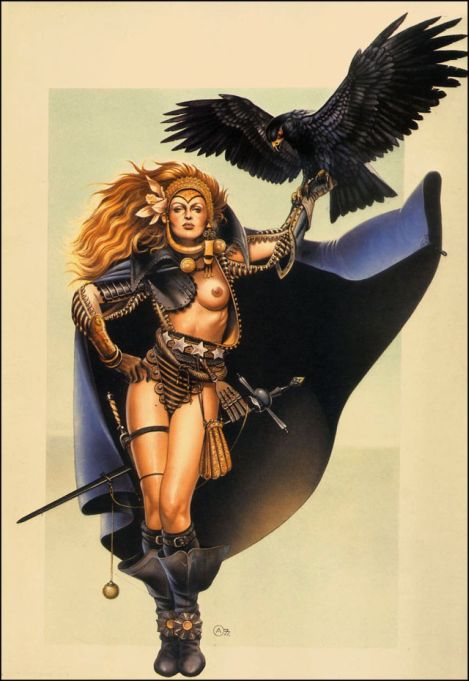
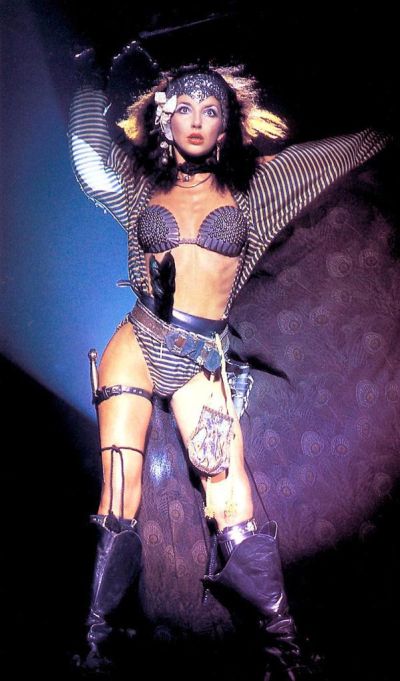
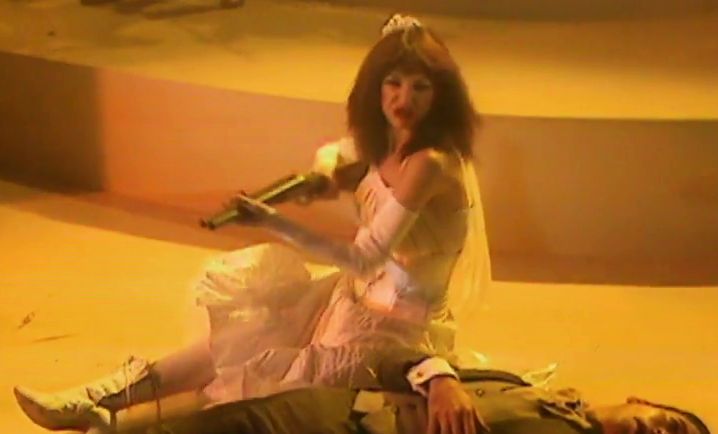







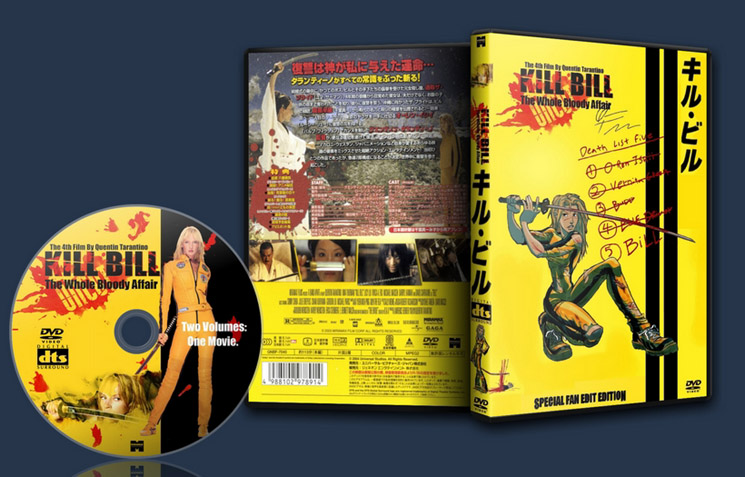 ★★★★½
★★★★½ In terms of content, there isn’t much alteration, with the only real change, a small but significant cut at the end of Volume 1. What’s removed, is Bill’s line, “Is she aware her daughter is still alive?” This means neither audience nor heroine know this, until she shows up at Bill’s house for the final confrontation. [I have to say, her daughter certainly doesn’t seem like a four-year old either.] Rather than substance, the biggest difference for me was stylistic: the overall balance seemed more even, as a single entity, than seen as two separate pieces months apart. Volume 2 seemed excessively talky on its own. While that’s still the case, it’s to a significantly lesser degree, being balanced directly by the first half, where The Bride engages in actions, not words. Indeed, the only person she kills in the second part is Bill, a sharp contrast to the pile of corpses left in her wake during its predecessor. His death still feels somewhat rushed, and it’s a shame the original ending – a swordfight between Bill and Beatrix, clad in her wedding dress, on the beach – couldn’t be filmed, because the production went over time.
In terms of content, there isn’t much alteration, with the only real change, a small but significant cut at the end of Volume 1. What’s removed, is Bill’s line, “Is she aware her daughter is still alive?” This means neither audience nor heroine know this, until she shows up at Bill’s house for the final confrontation. [I have to say, her daughter certainly doesn’t seem like a four-year old either.] Rather than substance, the biggest difference for me was stylistic: the overall balance seemed more even, as a single entity, than seen as two separate pieces months apart. Volume 2 seemed excessively talky on its own. While that’s still the case, it’s to a significantly lesser degree, being balanced directly by the first half, where The Bride engages in actions, not words. Indeed, the only person she kills in the second part is Bill, a sharp contrast to the pile of corpses left in her wake during its predecessor. His death still feels somewhat rushed, and it’s a shame the original ending – a swordfight between Bill and Beatrix, clad in her wedding dress, on the beach – couldn’t be filmed, because the production went over time. What hasn’t changed is the sheer, unadulterated awesomeness of the fights, as jaw-droppingly brutal and intense as they were ten years ago. Yuen Wo-Ping certainly cements his position as the most inventive and effective martial arts choreographer in history. Though this version has the entire House of Blue Leaves fight in colour, the arterial spray becomes
What hasn’t changed is the sheer, unadulterated awesomeness of the fights, as jaw-droppingly brutal and intense as they were ten years ago. Yuen Wo-Ping certainly cements his position as the most inventive and effective martial arts choreographer in history. Though this version has the entire House of Blue Leaves fight in colour, the arterial spray becomes 


































 It certainly is a show ‘for mature viewers,’ containing its fair share of violence and sex, which has naturally led to the usual accusations of the usual misogyny from the usual sources. I don’t think the reality is anywhere near as simple as this, not least because the creators are pretty much equal opportunity when it comes to character abuse. Sure, sexual assault is skewed towards the women; decapitation, on the other hand, is pretty much a male preserve. No-one gets out unscathed: man, woman, child or wolf. There’s also an obvious difference between depiction and endorsement. And it’d be kinda ludicrous to have a medieval-styled fantasy world, operating as some kind of anarcho-syndicalist commune, where people take it in turns to be a sort of executive officer for the week, but all the decisions of that officer have to be ratified at a special bi-weekly meeting. Boring as shit, too.
It certainly is a show ‘for mature viewers,’ containing its fair share of violence and sex, which has naturally led to the usual accusations of the usual misogyny from the usual sources. I don’t think the reality is anywhere near as simple as this, not least because the creators are pretty much equal opportunity when it comes to character abuse. Sure, sexual assault is skewed towards the women; decapitation, on the other hand, is pretty much a male preserve. No-one gets out unscathed: man, woman, child or wolf. There’s also an obvious difference between depiction and endorsement. And it’d be kinda ludicrous to have a medieval-styled fantasy world, operating as some kind of anarcho-syndicalist commune, where people take it in turns to be a sort of executive officer for the week, but all the decisions of that officer have to be ratified at a special bi-weekly meeting. Boring as shit, too. 7. Ygritte
7. Ygritte 2. Brienne of Tarth
2. Brienne of Tarth


























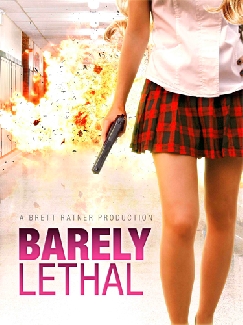












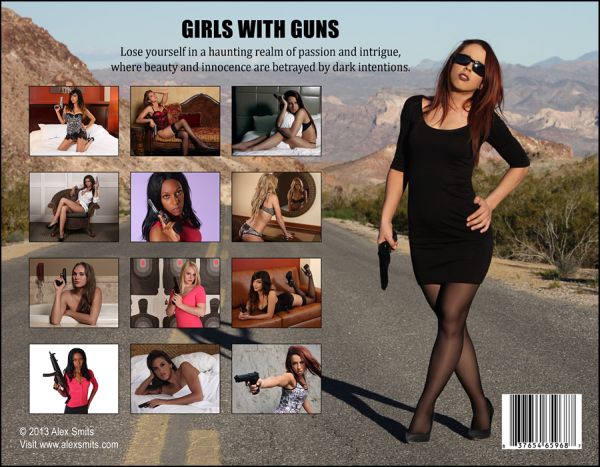
 We’ve covered a couple of entries in the series previously, but I’ve decided to start work a rather more comprehensive set of reviews, systematically watching them in order, rather than the sporadic pieces previously published, as they fell across my retinas. Some of those pieces were also reprints from a previous publication, and were also shorter than the ones I’ve grown accustomed to writing. This was largely inspired by stumbling across the first movie, dating from the seventies, and realizing that I could now cover the entire set. I hate incompleteness. :) This will be an ongoing project, likely taking me through the winter and into next spring, so check back often (okay: fairly often!) for updates.
We’ve covered a couple of entries in the series previously, but I’ve decided to start work a rather more comprehensive set of reviews, systematically watching them in order, rather than the sporadic pieces previously published, as they fell across my retinas. Some of those pieces were also reprints from a previous publication, and were also shorter than the ones I’ve grown accustomed to writing. This was largely inspired by stumbling across the first movie, dating from the seventies, and realizing that I could now cover the entire set. I hate incompleteness. :) This will be an ongoing project, likely taking me through the winter and into next spring, so check back often (okay: fairly often!) for updates.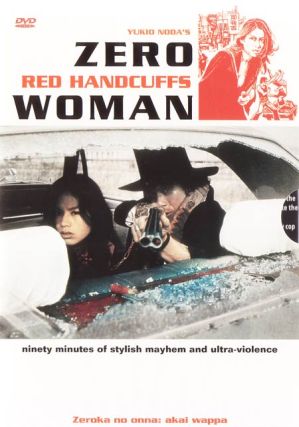 When the series started in 1974, it originally appeared to be trying to take on the Female Convict Scorpion series at its own game – both were inspired by Toru Shinohara manga series. However, going by the fact it took more than two decades for a second entry in the series, I can only presume the commercial returns weren’t anywhere near as strong. This starts off well, with policewoman Rei (Sugimoto) luring in, and then blowing away, the man responsible for torturing and killing another woman. Turns out the perpetrator was a diplomat and in the resulting scandal, Rie is sent to jail. Her chance at redemption comes when a gang of thugs stumble into the kidnapping of the daughter of a politician (Tamba): to avoid a scandal, Rie is offered a pardon if she infiltrates the kidnappers and kills them all. Initially, all goes to plan, with the first member taken out quickly, but it soon becomes clear the other members are rampaging psychos, and the situation rapidly spirals out of control, to the point where the politician yanks his support and orders the deaths of everyone, in the name of damage limitation – including both his daughter and Rie.
When the series started in 1974, it originally appeared to be trying to take on the Female Convict Scorpion series at its own game – both were inspired by Toru Shinohara manga series. However, going by the fact it took more than two decades for a second entry in the series, I can only presume the commercial returns weren’t anywhere near as strong. This starts off well, with policewoman Rei (Sugimoto) luring in, and then blowing away, the man responsible for torturing and killing another woman. Turns out the perpetrator was a diplomat and in the resulting scandal, Rie is sent to jail. Her chance at redemption comes when a gang of thugs stumble into the kidnapping of the daughter of a politician (Tamba): to avoid a scandal, Rie is offered a pardon if she infiltrates the kidnappers and kills them all. Initially, all goes to plan, with the first member taken out quickly, but it soon becomes clear the other members are rampaging psychos, and the situation rapidly spirals out of control, to the point where the politician yanks his support and orders the deaths of everyone, in the name of damage limitation – including both his daughter and Rie. Probably the least accurate title of any film ever – at least Friday the 13th put out a few movies before using “final” – you definitely should begin here if you’re looking for much coherence. Rei (Iijima) is now partly employed as secretary to the head of Section Zero, but also takes out criminals for whom traditional channels of law enforcement aren’t enough, for one reason or another. She also pals around with Takako (Fukuoka), a detective from another section and a girl he helped bring out of delinquency, in what’s vaguely intimated as a love triangle. One night, they witness a hit and run, and discover the perpetrator (Suzuki) is the daughter of a powerful economic figure. Despite encountering official resistance, Rei and Takako persist with their investigation and, inevitably, this brings out more robust sanctions.
Probably the least accurate title of any film ever – at least Friday the 13th put out a few movies before using “final” – you definitely should begin here if you’re looking for much coherence. Rei (Iijima) is now partly employed as secretary to the head of Section Zero, but also takes out criminals for whom traditional channels of law enforcement aren’t enough, for one reason or another. She also pals around with Takako (Fukuoka), a detective from another section and a girl he helped bring out of delinquency, in what’s vaguely intimated as a love triangle. One night, they witness a hit and run, and discover the perpetrator (Suzuki) is the daughter of a powerful economic figure. Despite encountering official resistance, Rei and Takako persist with their investigation and, inevitably, this brings out more robust sanctions.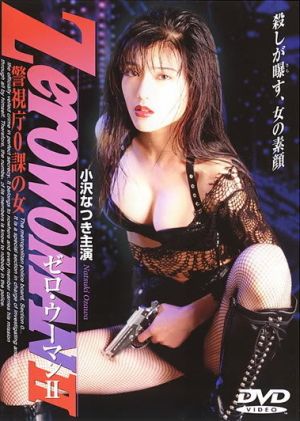 Confusingly titled in the West, without any indication it wasn’t the first of the rebooted franchise, this perhaps explains why there’s little or no explanation of… Well, anything, really. What is Section Zero? Who is Rei? Where did she come from? “Never mind about that,” seems to be the film’s attitude, “Here are Natsuki Ozawa’s breasts to distract you from such trifles.” That’s particularly the case early on, when it seems Rei is unable to go five minutes without showing them off, whether it’s through being molested, becoming inescapably randy or simply taking a soapy shower (to wash off the blood after a kill, so I guess it’s a shower necessary to the plot – it also replays the intruder shower scene from its predecessor, with a different ending).
Confusingly titled in the West, without any indication it wasn’t the first of the rebooted franchise, this perhaps explains why there’s little or no explanation of… Well, anything, really. What is Section Zero? Who is Rei? Where did she come from? “Never mind about that,” seems to be the film’s attitude, “Here are Natsuki Ozawa’s breasts to distract you from such trifles.” That’s particularly the case early on, when it seems Rei is unable to go five minutes without showing them off, whether it’s through being molested, becoming inescapably randy or simply taking a soapy shower (to wash off the blood after a kill, so I guess it’s a shower necessary to the plot – it also replays the intruder shower scene from its predecessor, with a different ending).
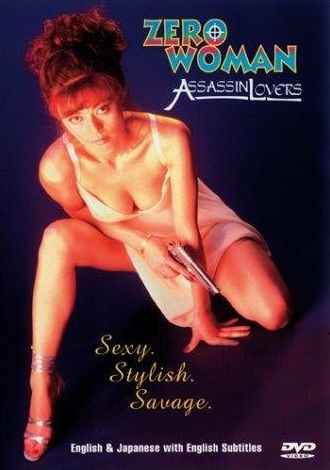
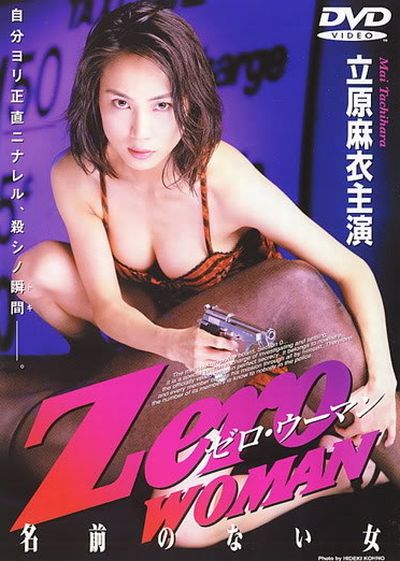 After the genuinely impressive bleakness of Assassin Lovers, the series comes crashing back to earth with a splat like a rotten tomato for this entry, which fizzles out early on, and then manages to lumber on for another 45 minutes. Rei (Tachihara) spends her time between missions hanging out at a gay bar, and rescues one of the rent boys, Mitsusu (Kitagawa), who ply their trade there after a vicious assault – accompanied, it has to be said, by the least appropriate music in the history of cinematic homosexual rape. He ends up moving in with her, to the latest in a series of unfurnished apartments provided by Section Zero, and the two damaged individuals start creating a life, of sorts, for themselves. However, there’s a serial killer, apparently with a deep hatred of men, operating in the area, and Rei is given the mission of tracking down and eliminating the psycho.
After the genuinely impressive bleakness of Assassin Lovers, the series comes crashing back to earth with a splat like a rotten tomato for this entry, which fizzles out early on, and then manages to lumber on for another 45 minutes. Rei (Tachihara) spends her time between missions hanging out at a gay bar, and rescues one of the rent boys, Mitsusu (Kitagawa), who ply their trade there after a vicious assault – accompanied, it has to be said, by the least appropriate music in the history of cinematic homosexual rape. He ends up moving in with her, to the latest in a series of unfurnished apartments provided by Section Zero, and the two damaged individuals start creating a life, of sorts, for themselves. However, there’s a serial killer, apparently with a deep hatred of men, operating in the area, and Rei is given the mission of tracking down and eliminating the psycho.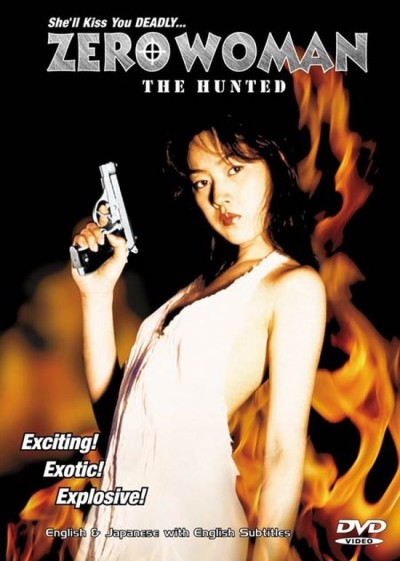 If ever I become an evil overlord, I will ensure my minions’ idea of security does not involve walking slowly in the open, towards an attacker, while firing wide of them from a range no greater than a slightly oversize dinner-table. That’s the first thing we take from this, which begins with a thoroughly implausible scene where Rei (Ono, who had been a part of 90’s J-pop group CoCo) manages to drown her target, a German industrialist, despite him being roughly twice her size, and without anyone in or around the swimming-pool noticing anything. She then climbs out, pulling a gun from who knows where, kills bodyguards who’d fail the Imperial Stormtrooper accuracy exam, and abseils down the side of the building to escape. That sets the tone for much of what follows, combining a reunion with someone from her past, a blossoming relationship with a chef, and her boss’s traditional surly reluctance to allow anything as banal as “personal happiness” to distract his #1 killer from her work.
If ever I become an evil overlord, I will ensure my minions’ idea of security does not involve walking slowly in the open, towards an attacker, while firing wide of them from a range no greater than a slightly oversize dinner-table. That’s the first thing we take from this, which begins with a thoroughly implausible scene where Rei (Ono, who had been a part of 90’s J-pop group CoCo) manages to drown her target, a German industrialist, despite him being roughly twice her size, and without anyone in or around the swimming-pool noticing anything. She then climbs out, pulling a gun from who knows where, kills bodyguards who’d fail the Imperial Stormtrooper accuracy exam, and abseils down the side of the building to escape. That sets the tone for much of what follows, combining a reunion with someone from her past, a blossoming relationship with a chef, and her boss’s traditional surly reluctance to allow anything as banal as “personal happiness” to distract his #1 killer from her work. The main mission given to Rie (Shiratori this time) is a little bit different, from her usual, straight-forward assassinations. Instead, she’s given the job of protecting a witness. Nana (Matsuda), the disgruntled mistress of an organ-trafficking ring, who has had enough and agreed to co-operate with the police. Rie is part of the protection detail, but soon finds out that the gangsters, under ever-so strange boss Kaneda (Nogami) with his transvestite tendencies, are not going to sit back and wait for Nana to take the witness stand. Oddly, the cops let Nana stay in her own apartment, perhaps figuring that’s the last place her former lover would look. but when that is unsurprisingly stormed, Rie takes the target back to the operative’s flat, where they hang out, exchanging small talk – that’s mostly Nana, of course, since Rie is about as talkative as the enormous pet fish she has in a tank, and to which she feeds goldfish.
The main mission given to Rie (Shiratori this time) is a little bit different, from her usual, straight-forward assassinations. Instead, she’s given the job of protecting a witness. Nana (Matsuda), the disgruntled mistress of an organ-trafficking ring, who has had enough and agreed to co-operate with the police. Rie is part of the protection detail, but soon finds out that the gangsters, under ever-so strange boss Kaneda (Nogami) with his transvestite tendencies, are not going to sit back and wait for Nana to take the witness stand. Oddly, the cops let Nana stay in her own apartment, perhaps figuring that’s the last place her former lover would look. but when that is unsurprisingly stormed, Rie takes the target back to the operative’s flat, where they hang out, exchanging small talk – that’s mostly Nana, of course, since Rie is about as talkative as the enormous pet fish she has in a tank, and to which she feeds goldfish.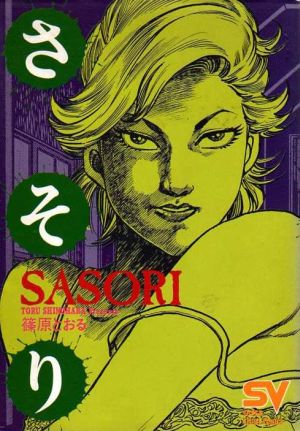 In the first half of the 1970’s, Meiko Kaji was to the slightly-disreputable end of Japanese cinema, much what Pam Grier was to the same end of Hollywood movies. Both made a career out of playing strong female characters, often operating on or beyond the boundaries of the law, and with no compunction about using violence to achieve their ends – which often involved taking revenge on those (almost alwayx men) who had wronged them. The Sasori [Japanese for “scorpion”] was not Kaji’s first foray into the genre, having cut her teeth on the Noraneko Rokku [Straycat or Alleycat Rock] films, a couple of years previously.
In the first half of the 1970’s, Meiko Kaji was to the slightly-disreputable end of Japanese cinema, much what Pam Grier was to the same end of Hollywood movies. Both made a career out of playing strong female characters, often operating on or beyond the boundaries of the law, and with no compunction about using violence to achieve their ends – which often involved taking revenge on those (almost alwayx men) who had wronged them. The Sasori [Japanese for “scorpion”] was not Kaji’s first foray into the genre, having cut her teeth on the Noraneko Rokku [Straycat or Alleycat Rock] films, a couple of years previously.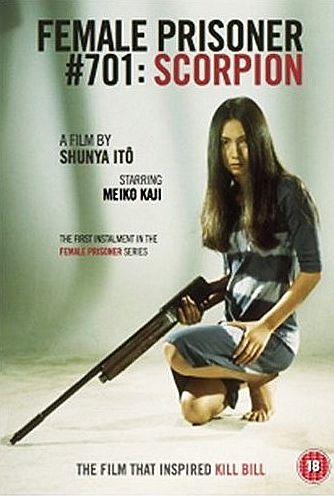
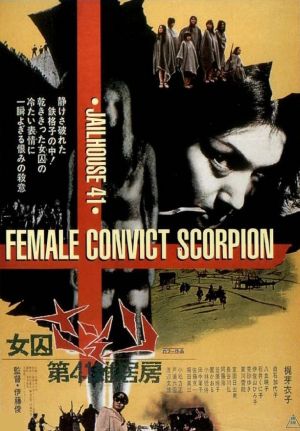 Right from the start, Nami (Kaji) established her utterly hardcore credentials, as she’s trying to dig her way out of the dungeon where she has been for the past year. With a spoon. Held in her teeth. She’s let out for the day because a bigwig is visiting, but takes the opportunity to attack warden Goda (Watanabe), almost depriving him of the sight of his other eye. As punishment for the resulting riot, Goda sends four guards to gang-rape Nami, and all the inmates are sent to a hard-labour camp. On the way back, they beat Nami as punishment, leaving her near-dead but it turns out that was just her ruse to get the guards to open the back of the van and escape. She leads the women across a blasted landscape, revenge once more on her mind, with Goda’s men in hot pursuit.
Right from the start, Nami (Kaji) established her utterly hardcore credentials, as she’s trying to dig her way out of the dungeon where she has been for the past year. With a spoon. Held in her teeth. She’s let out for the day because a bigwig is visiting, but takes the opportunity to attack warden Goda (Watanabe), almost depriving him of the sight of his other eye. As punishment for the resulting riot, Goda sends four guards to gang-rape Nami, and all the inmates are sent to a hard-labour camp. On the way back, they beat Nami as punishment, leaving her near-dead but it turns out that was just her ruse to get the guards to open the back of the van and escape. She leads the women across a blasted landscape, revenge once more on her mind, with Goda’s men in hot pursuit.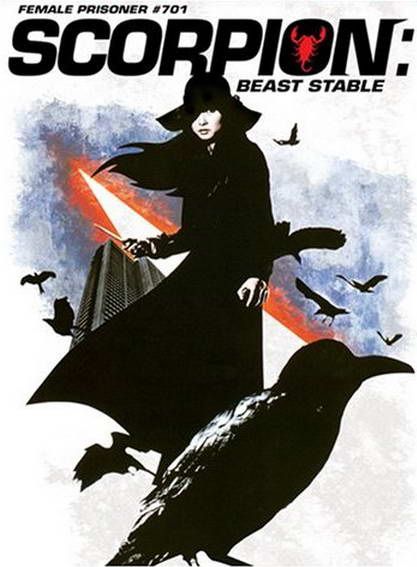 When this begins, Nami (Kaji) is on the run, and slices the arm off Detective Kondo (Narita) after he handcuffs himself to her. She befriends street hooker Yuki (Watanabe), who runs foul of the locak Yakuza gang by turning tricks on their turn, while trying to care for her brain-damaged brother, whom she also services sexually, to stop him from raping women(!). After Nami is involved in the death of a gang member who was blackmailing her, the gang’s madam Katsu (Lee), who knew the Scorpion from her own prison days, captures her, locking our heroine up in a literal big bird-cage. But after the true horror of the Yakuza’s treatment of their women is revealed (it starts with a golf-club going where no golf-club should ever go), Nami escapes and carves a bloody path of revenge on those responsible. When Katsu realizes what’s going on, she turns herself in to the police, figuring jail will be safe from Sasori’s wrath. Take a wild stab in the dark… Which, by coincidence is exactly what Katsu deserves.
When this begins, Nami (Kaji) is on the run, and slices the arm off Detective Kondo (Narita) after he handcuffs himself to her. She befriends street hooker Yuki (Watanabe), who runs foul of the locak Yakuza gang by turning tricks on their turn, while trying to care for her brain-damaged brother, whom she also services sexually, to stop him from raping women(!). After Nami is involved in the death of a gang member who was blackmailing her, the gang’s madam Katsu (Lee), who knew the Scorpion from her own prison days, captures her, locking our heroine up in a literal big bird-cage. But after the true horror of the Yakuza’s treatment of their women is revealed (it starts with a golf-club going where no golf-club should ever go), Nami escapes and carves a bloody path of revenge on those responsible. When Katsu realizes what’s going on, she turns herself in to the police, figuring jail will be safe from Sasori’s wrath. Take a wild stab in the dark… Which, by coincidence is exactly what Katsu deserves. Nami (Kaji) is about to get married, but her wedding day is rudely interrupted by the arrival of the cops, who arrest her. On the way to prison (and, unsurprisingly, death row, given the body count left behind in the previous three movies), she takes out the driver, causing a crash. The injured Scorpion staggers away, and is rescued by Kudo (Tamura), a former political radical who was brutalized by the police for his actions, and so has a massive load of resentment against them. After being informed of Kudo’s harbouring of Nami by a worked at the sex-club where he works, the cops take him in: and use both physical and psychological torture to try and make him give up her location. Eventually arrested, Nami is sentenced to death, but the cops intend to make sure the time leading up to her execution is as unpleasant and possible, and the detective in charge, Hirose (Tsukata), is intent on making even Nami’s death as lonely an experience as possible.
Nami (Kaji) is about to get married, but her wedding day is rudely interrupted by the arrival of the cops, who arrest her. On the way to prison (and, unsurprisingly, death row, given the body count left behind in the previous three movies), she takes out the driver, causing a crash. The injured Scorpion staggers away, and is rescued by Kudo (Tamura), a former political radical who was brutalized by the police for his actions, and so has a massive load of resentment against them. After being informed of Kudo’s harbouring of Nami by a worked at the sex-club where he works, the cops take him in: and use both physical and psychological torture to try and make him give up her location. Eventually arrested, Nami is sentenced to death, but the cops intend to make sure the time leading up to her execution is as unpleasant and possible, and the detective in charge, Hirose (Tsukata), is intent on making even Nami’s death as lonely an experience as possible. Just goes to show that the “cinematic reboot” is not a 21st-century invention, e.g. Batman or James Bond. For a mere three years after Meiko Kaji showed her sting as Nami, the studio reset the series, giving it a new director, new (and much more talkative) lead actress, and returning Nami Matsushima to a happy, criminal record-free young women, with a loving boyfriend. Except, of course, he turns out not to love her quite as much. Things start to collapse after her sister uncovers evidence of major government corruption, and passes it to Nami, shortly before being kidnapped. After Nami uncovers the truth – her sister is killed and she is framed for the murder, with the help of her boyfriend, and sentenced to 15 years in prison. Initially an easy mark for the tough girls in her cell, Nami soon develops her mean streak. And she’s going to need it, because the politician behind it all is looking to tidy up the loose end she represents, by killing her and making the death look like a suicide. Name turns the tables, in incendiary fashion, and it’s clear that she’s one loose end that won’t be quietly disposed of.
Just goes to show that the “cinematic reboot” is not a 21st-century invention, e.g. Batman or James Bond. For a mere three years after Meiko Kaji showed her sting as Nami, the studio reset the series, giving it a new director, new (and much more talkative) lead actress, and returning Nami Matsushima to a happy, criminal record-free young women, with a loving boyfriend. Except, of course, he turns out not to love her quite as much. Things start to collapse after her sister uncovers evidence of major government corruption, and passes it to Nami, shortly before being kidnapped. After Nami uncovers the truth – her sister is killed and she is framed for the murder, with the help of her boyfriend, and sentenced to 15 years in prison. Initially an easy mark for the tough girls in her cell, Nami soon develops her mean streak. And she’s going to need it, because the politician behind it all is looking to tidy up the loose end she represents, by killing her and making the death look like a suicide. Name turns the tables, in incendiary fashion, and it’s clear that she’s one loose end that won’t be quietly disposed of.



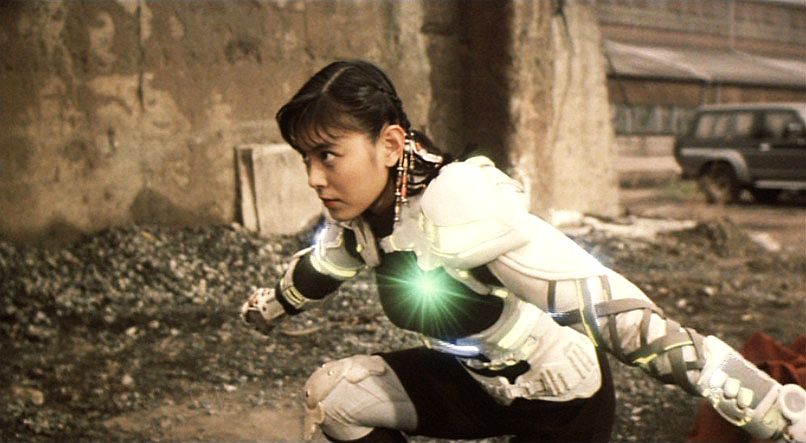 “Z is for Zeiram”
“Z is for Zeiram”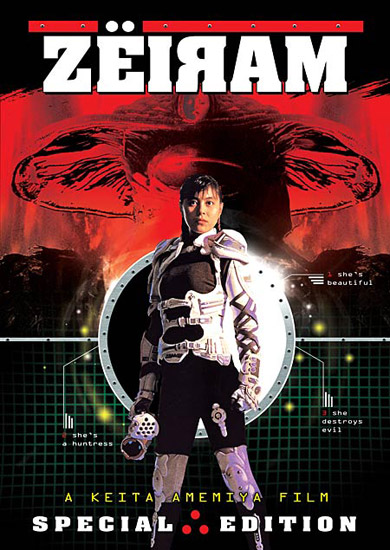 Zeiram and its sequel, Zeiram 2, both concern a creature which combines all the most unpleasant and lethal features of The Thing with The Terminator. It’s humanoid, at least in the number of functioning limbs, but its head appears almost mushroom shaped – though it’s hard to tell where Zeiram ends and its hat begins, for there’s a second face, embedded in the hat. This is capable of extending on a tentacle, to attack victims, taking in nourishment, and there’s evidence to suggest that it can absorb their DNA and use it to create monsters. Oh, and the rest of it is almost impossible to destroy.
Zeiram and its sequel, Zeiram 2, both concern a creature which combines all the most unpleasant and lethal features of The Thing with The Terminator. It’s humanoid, at least in the number of functioning limbs, but its head appears almost mushroom shaped – though it’s hard to tell where Zeiram ends and its hat begins, for there’s a second face, embedded in the hat. This is capable of extending on a tentacle, to attack victims, taking in nourishment, and there’s evidence to suggest that it can absorb their DNA and use it to create monsters. Oh, and the rest of it is almost impossible to destroy.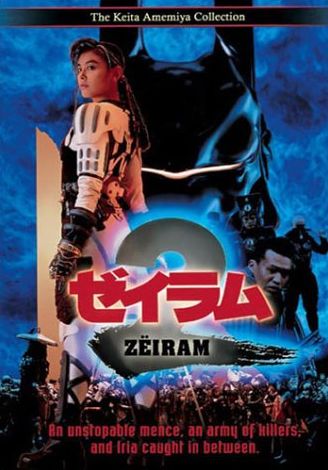 The sequel, which came out three years later, restores the “i” in the title, which was inexplicably removed from the original for it US release by Fox Lorber. This installment starts off as if it’s going to go in some radically different directions, even if all the main players are back. Iria is seeking an ancient artifact called the Carmarite, and additionally, has a new assistant, but he turns out to be untrustworthy. Meanwhile, a shadowy group has succeeded in regenerating Zeiram as a cyborg warrior (which makes a lot more sense if you’ve seen the anime, and know its origins), bending its will to their needs and turning it into a weapon. While initially successfully, this works about as well as most plans usually do, and it’s not longer before Zeiram is much more a menace than an ally.
The sequel, which came out three years later, restores the “i” in the title, which was inexplicably removed from the original for it US release by Fox Lorber. This installment starts off as if it’s going to go in some radically different directions, even if all the main players are back. Iria is seeking an ancient artifact called the Carmarite, and additionally, has a new assistant, but he turns out to be untrustworthy. Meanwhile, a shadowy group has succeeded in regenerating Zeiram as a cyborg warrior (which makes a lot more sense if you’ve seen the anime, and know its origins), bending its will to their needs and turning it into a weapon. While initially successfully, this works about as well as most plans usually do, and it’s not longer before Zeiram is much more a menace than an ally.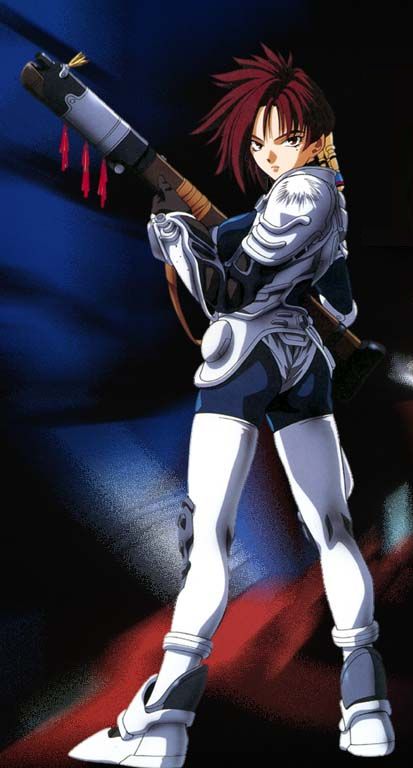 Though released several years later, this is a prequel to the two Zeiram movies, telling the story of the first encounter between Iria (Hisakawa, who was also Sailor Mercury) and Zeiram. At the time, she was an apprentice bounty-hunter, working alongside her brother Gren. They take a mission to rescue a VIP and recover the cargo from a stranded space-ship. However, once there, they discover the “cargo” is actually the alien Zeiram, which a corporation is interested in using as a weapon. The result leaves her brother apparently dead, and Iria now the target for the corporation, who want to hush up their thoroughly-dubious plan, by any means necessary. Fortunately, as well as her own skills, our heroine has the assistance of former rival bounty-hunter, Fujikuro (Chiva), endearing urchin Kei (Kanai), and Bob (Ikeda), a colleague whose consciousness has been turned into an AI.
Though released several years later, this is a prequel to the two Zeiram movies, telling the story of the first encounter between Iria (Hisakawa, who was also Sailor Mercury) and Zeiram. At the time, she was an apprentice bounty-hunter, working alongside her brother Gren. They take a mission to rescue a VIP and recover the cargo from a stranded space-ship. However, once there, they discover the “cargo” is actually the alien Zeiram, which a corporation is interested in using as a weapon. The result leaves her brother apparently dead, and Iria now the target for the corporation, who want to hush up their thoroughly-dubious plan, by any means necessary. Fortunately, as well as her own skills, our heroine has the assistance of former rival bounty-hunter, Fujikuro (Chiva), endearing urchin Kei (Kanai), and Bob (Ikeda), a colleague whose consciousness has been turned into an AI.
 Joan of Arc
Joan of Arc Such tactics were necessary in Western society because of the increasing belief that women were not “fit” for combat. It was still possible as late as 1915, when Dorothy Lawrence (right) posed as a man to reach the Somme front-lines, where she laid mines, until illness forced her to reveal her identity. Her memoirs are available, free,
Such tactics were necessary in Western society because of the increasing belief that women were not “fit” for combat. It was still possible as late as 1915, when Dorothy Lawrence (right) posed as a man to reach the Somme front-lines, where she laid mines, until illness forced her to reveal her identity. Her memoirs are available, free, 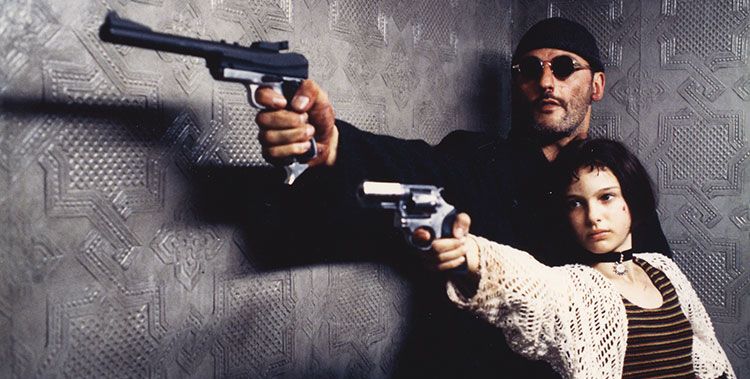
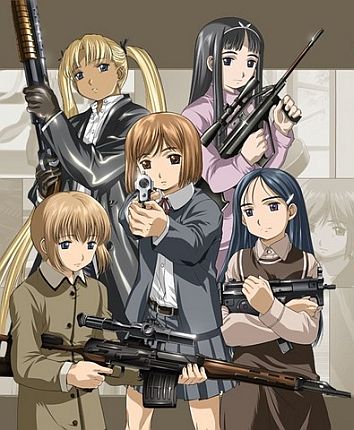 In a somewhat more light-hearted vein (for the most part), many anime and manga series have had teenage protagonists – as you’d expect, given they are often the core audience. The archetype goes back at least to the mid-1950’s, and Osama Tezuka’s Princess Knight, about a princess who must pretend to be male, so she can inherit the throne. There are too many of these even to list here, but some of the most well-known action-oriented examples in the West include Project A-ko, Sailor Moon, Blood: The Last Vampire, Cutie Honey, Gunslinger Girl (left), Noir and Dirty Pair – particularly Dirty Pair Flash, where both Kei and Yuri are seventeen-year olds.
In a somewhat more light-hearted vein (for the most part), many anime and manga series have had teenage protagonists – as you’d expect, given they are often the core audience. The archetype goes back at least to the mid-1950’s, and Osama Tezuka’s Princess Knight, about a princess who must pretend to be male, so she can inherit the throne. There are too many of these even to list here, but some of the most well-known action-oriented examples in the West include Project A-ko, Sailor Moon, Blood: The Last Vampire, Cutie Honey, Gunslinger Girl (left), Noir and Dirty Pair – particularly Dirty Pair Flash, where both Kei and Yuri are seventeen-year olds.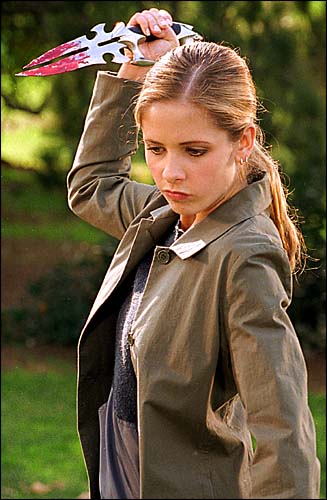 Quick: name a film where Saoirse Ronan plays a teenage assassin – besides Hanna. She seems to have developed a taste for the genre, as she also plays one in Violet & Daisy, directed by Geoffrey Fletcher (the screenwriter for Oscar-winner Precious). She is Daisy, along with Alexis Bledel as Violet: the two young killers for hire accept what they think will be a quick-and-easy job, until an unexpected target throws them off their plan.
Quick: name a film where Saoirse Ronan plays a teenage assassin – besides Hanna. She seems to have developed a taste for the genre, as she also plays one in Violet & Daisy, directed by Geoffrey Fletcher (the screenwriter for Oscar-winner Precious). She is Daisy, along with Alexis Bledel as Violet: the two young killers for hire accept what they think will be a quick-and-easy job, until an unexpected target throws them off their plan.  But his reading of the movie says a lot more about the writer than the film: as another critic
But his reading of the movie says a lot more about the writer than the film: as another critic